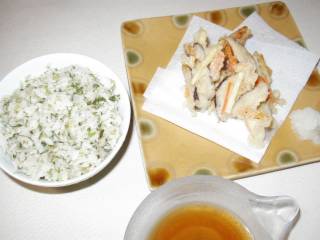
Kakiage dinner I had last night
Do you know what Tempeh is? I had heard about it, but never actually seen one until I found this in a nearby supermarket the other day.

Temphe
Now I learned that this is a very nutritious food originally from Indonesia, and it has the nutrition that is similar to our natto. Then it must be a blessing for me, because I’m not crazy about the slimy feel of natto, but want to benefit from its excellent nutrition. I took a bite of the temphe, and I liked it better than natto. OK, now..... what could be a quick and easy way to try this new ingredient?
On the other hand, I had some leaves of daikon (Japanese horseradish?) my colleague gave me last week.

Daikon leaves
This is a local thing. Elder people in small farming villages often use daikon leaves for cooking (or feed chickens with them), but I don’t think it’s common in big cities. Anyway, I like mixing minced and seasoned daikon leaves with cooked rice, so that would be my choice for supper.
Then I thought about all the leftovers in my kitchen, and finally decided to make Kakiage (a kind of tempura) with the tempeh. When you make kakiage, you deep-fry almost any kind of shredded vegetables and diced seafood in thin batter. (Actually this can be a good fridge-cleaning recipe :P ) So I prepared the daikon leaves first. I washed and minced them, fried them with dried baby fish in a little veg. oil and sesame oil, then seasoned with salt, sake, soy sauce and added white sesame seeds. Then I mixed it with cooked rice, and let them cool. Next, I shredded leftover carrots, a sweet potato, a shiitake mushroom and the tempeh, and made kakiage.
It was a good meal, except I didn’t taste the tempeh in the kakiage very much. Next time, I might try frying tempeh alone, with cheese or something. Anyway, I’m 100% sure that exploring new tempeh recipes will be so much fun.
|
![]()

![]()
9 comments:
I am surprise to see Tempeh being sold in Japan! Tempeh is mostly eaten by Malay here in Malaysia, but I have also acquired a taste for it. I especailly liked it shallow-fried in oil until golden brown. Here, we eat it cooked in sambal(it's a sort of chilli paste) and in Lontong. Nice :)
Posted by vooney
Hi vooney
Thanks for stopping by and leaving a comment. Sorry for the late response!
Yes, I was surprised to see Tempeh at a nearby supermarket. I read about it in a women's magazine, but didn't think it was that popular in this rural area. Fried tempeh is so good, isn't it? Must be nice in sambal, too.
Posted by obachan
Tempeh is fermented soy. Like vooney said, it's eaten here in Malaysia as well.
The last comment was from me. Forgot to include my nickname.
Hi amber amethryne,
Thanks for your comment. I think it's a good thing that this kind of nutritious food gains popularity in many countries.
that is great that tempeh is in japan! i live in tokyo and am looking for it. could you tell me where to buy it?
my email is bmiller@crisscross.com
thanks!
Hi anonymous commenter,
Thanks for your comment. I've never lived in Tokyo, but considering the fact that many supermarkets here in this small city sell tempeh now, I guess you can find it at most middle-sized supermarkets there. It should be on the shelf near tofu or natto, I guess.
Here I saw it in Jusco and two other local supermarkets.
Hope this helps.
Hello. I live in the USA and produced tempeh for 9 years where it was received with open arms. Now we have a non profit foundation doing educational outreach for anyone interested in learning how to make it. This is an easy method for anyone.
See http://www.maketempeh.org
Enjoy
Betsy Shipley
Betsy's Tempeh Foundation
There is an Indonesian living in Kyoto who has been producing tempeh. His name is Rustono and his product is Rusto's Tempeh. He wants to be the King of Tempeh in Japan. Nice aspiration. He has returned to Indonesia to study how to make tempeh in the country where tempeh comes from. Why not try to find his product or find more about him on the Internet?
Post a Comment